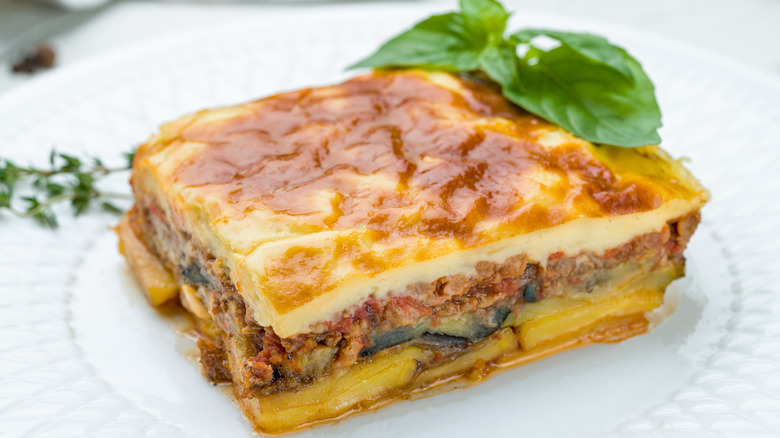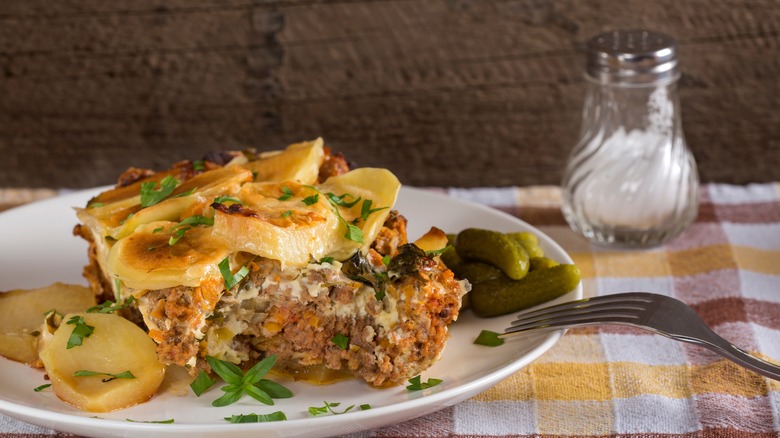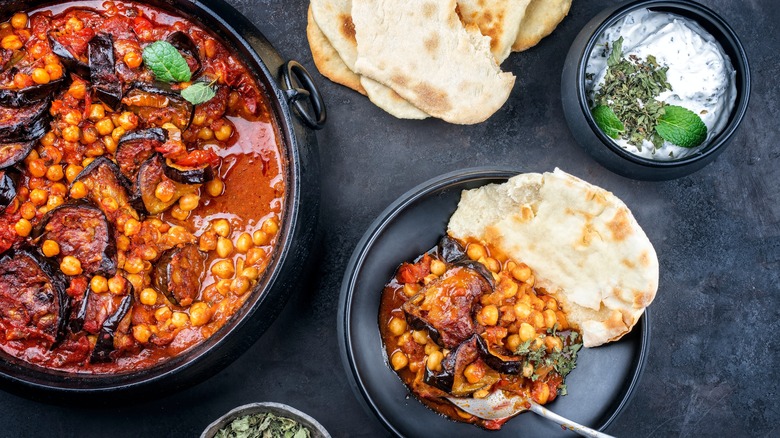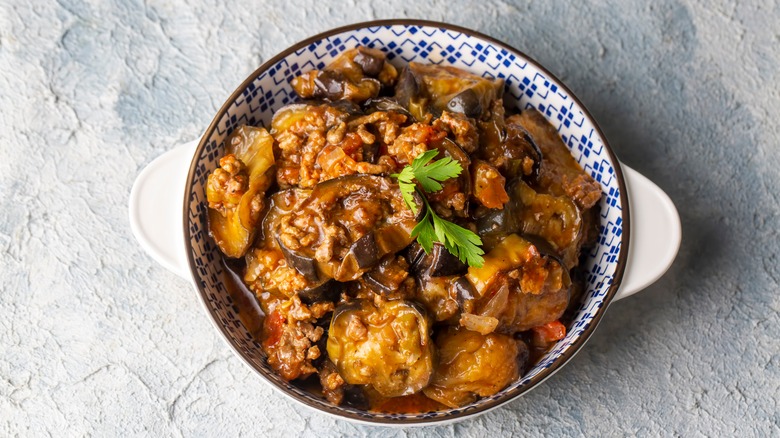How Moussaka Varies Around The World
Some dishes endorse reinterpretation, with nearly every preparation entailing a distinct spin. In many Middle Eastern and European cuisines, moussaka is such a food. Based around a simple backbone of ground meats mixed with fried vegetables — most notably eggplant — the dish takes on a wide range of formats.
The most popularized version stems from Greece, which is now interlinked with the dish. This version layers beef or lamb in between eggplant, with a creamy bechamel and cheesy topping to complement. Yet even this rendition is a relative newcomer, first recorded by a Greek food writer at the beginning of the 20th century. Moussaka's roots trace back further, with a likely origin in Arabic cuisine. First printed in a 13th-century cookbook entitled "A Baghdad Cookery Book (Kitaab Al-Tabikh)", it has since spun off into versions found in the Balkans, North Africa, Turkey, the Levant, and more. Many are completely different than what's commonly associated with the dish in the U.S. — here are notable regional variations on moussaka.
Classic Greek moussaka layers eggplant and ground meat with a béchamel sauce
For many, Greek moussaka is the most familiar version of the dish. A lasagne-like creation, it's, in essence, a dense casserole, with layers of eggplant and ground meat, all covered in a béchamel sauce. Beyond that basic formula, the dish takes on abundant variations. From the utilized minced meat — which can be lamb, beef, or pork — to the béchamel composition and optional inclusion of potatoes.
Most frequently, the eggplant is fried separately from the prepared meat sauce. The latter typically uses tomatoes for its base, incorporating a medley of spices and aromatics ranging from garlic to bay leaf, cinnamon, and dried peppers. The béchamel sauce, which typically runs on the thicker side due to inclusions like eggs, flour, butter, and cheese, forms a topping. Some add breadcrumbs, while others reach for cheese. Flavors and ingredients may vary seasonally or per diners' taste, with vegetarian versions also common.
Balkan moussaka utilizes potatoes for a casserole-like dish
In the Balkan countries, the dish takes on a distinct identity, often forgoing eggplant completely. Instead, Balkan moussaka is a potato-based casserole layered with meat, dairy products, and eggs. As is characteristic of Greek moussaka, this Eastern European style also encompasses many variations, both regional and dependent on the chef.
In meat-loving Serbian cuisine, a medley of pork, turkey, beef, and veal can all go into the dish, perhaps with a sprinkle of beloved vegeta seasoning from neighboring Croatia. For a creamy topping, eggs are mixed with a milk-based product of choice, such as yogurt, sour cream, or heavy cream. The Bulgarian rendition is similar, except with vegetables like tomatoes making an appearance, as well as a sprinkling of local seasonings. In Albania, Mediterranean flavors like oregano and olive oil are utilized, with a milk-based egg mixture ladled over the components before cooking instead of as a topping. Exact renditions shift between borders and families, with some integrating eggplant, like in Greece. However, throughout the Balkans, the most common expectation is a hefty volume of potatoes per portion.
Lebanese moussaka is a richly spiced chickpea stew
In Lebanon and other nearby regions of the Levant, moussaka takes on a much more stew-like form. Known as maghmour, the dish makes a frequent appearance during mezze-style eating, sopped up alongside other sides like rice and bread. As opposed to other moussaka types, it utilizes chickpeas, which are simmered in a spiced tomato sauce. Eggplants are still present, but they're roasted rather than fried. The stew is prepared over the stove, with additions mixed in sans layering.
Most versions are completely vegetarian and constructed with aromatics like cinnamon, allspice, cumin, and ginger, which lend a complex, distinctly Middle Eastern flavor. Olive oil is another essential component, providing earthiness to the dish. And a sprinkling of chopped parsley rounds everything out with a bright herbal flavor. No cheese is present in this version; the aim of this dish is a thick and sumptuous consistency. Bold notes are served in a single spoonful, meaning this moussaka delivers big flavors in a small portion.
Other stew-like moussaka variations
In addition to Lebanon, many Muslim nations also prepare stew-like moussaka renditions, each with their own spin. In Turkey, the dish takes on a liquid consistency formed with an olive oil and tomato sauce base. There are no chickpeas or legumes to add structure, and there's a generous portion of minced meat, like with the Greek version. The utilized eggplants can be either roasted or fried, depending on preference. Turkish moussaka's most characteristic element is a reliance on peppers, which can be used in the dried form (aleppo), as a pepper paste, and as whole exemplars. This lends the dish an aromatic and oftentimes spicy character.
Meanwhile, in Egypt, the food is called mesaka'a and contains elements of both Lebanese and Turkish traditions. Its texture is more curry-like, with a bouquet of North African spices like cinnamon, cumin, and dried chile powders. Some versions add harissa, with all the aromatic components cooked into a tomato sauce. Peppers, minced meat, and chickpeas can all make an appearance, making it a version that embraces a wide range of influences. Served over rice, it showcases just how encompassing a dish moussaka can be.




